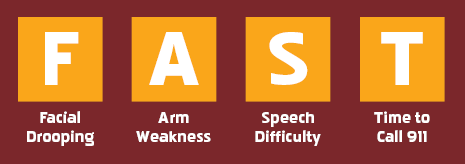
May is National Stroke Awareness Month. To support stroke awareness and prevention, the neurosurgeons at The Center encourage our community to reduce their risk of stroke, as well as learn the signs and symptoms of stroke.
What is a stroke?
A stroke is a brain injury caused by a disruption of blood flow to the brain. Without oxygen, brain cells die. There are two main types of stroke: ischemic and hemorrhagic. An ischemic stroke occurs when a blood vessel is blocked and stops blood flow to a part of the brain. The brain cells and tissues can die within minutes without oxygen and nutrients. A hemorrhagic stroke is caused by bleeding on the brain tissue, which may form a clot and stop blood flow.
Stroke prevention
Nearly 75% of strokes are associated with high blood pressure (hypertension). Some of the other risk factors include sedentary lifestyle, obesity, poor diet, and smoking. Smokers have up to four times increased risk of stroke. Recent research also shows evidence that people on birth control or receiving hormone replacement therapy have an overall 29 percent increased risk of stroke, in particular an ischemic stroke. If you have high blood pressure, or any of these risk factors, talk to your doctor about creating a plan to reduce your risk of stroke.
Signs and symptoms
The warning signs of a stroke can be remembered with the acronym FAST: facial drooping, arm weakness, speech difficulty, time to call 911. Stroke may occur suddenly and the results can be devastating. It is critical to call 911 immediately, so blood flow can be restored to the brain as quickly as possible. Other symptoms of stroke that may occur include severe headache, confusion, dizziness, nausea, loss of balance, numbness, trouble speaking or walking, vision changes, and weakness.

Treatment
An ischemic stroke is treated by removing the blockage from the blood vessel and restoring blood flow. A drug called tissue plasminogen activator (tPA) has a high success rate if it is administered within a three-hour window from the onset of symptoms. There are also surgical options; your neurosurgeon will recommend the best form of treatment depending on your health and your needs. A hemorrhagic stroke usually requires surgery to relieve pressure within the skull caused by bleeding.
Prevent a Second Stroke
More than seven million Americans are stroke survivors. For those people, the risk of having another stroke is higher than a person who has never had one. Although you can’t control some factors, like age, gender, and genetics, you can make lifestyle modifications to help prevent a second stroke. See your doctor regularly to help manage your blood pressure, take steps to stop smoking, and lose weight if you are overweight or obese. Learn how you can become more physically active and improve your diet to lower your risk of stroke as well as your overall health.





